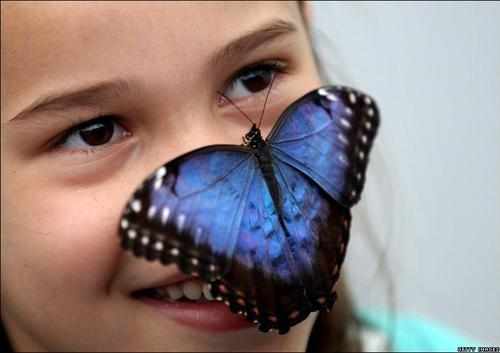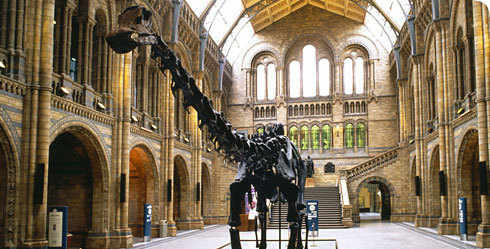| |
| Natural History Museum | 
Custom Search
|
The Natural History Museum first opened its doors to the public on Easter Monday in 1881, but its origins go back more than 250 years.
It all started when physician and collector of natural curiosities, Sir Hans Sloane, left his extensive collection to the nation in 1753.
Originally Sloane’s specimens formed part of the British Museum, but as other collections were added, including specimens collected by botanist Joseph Banks on his 1768-1771 voyage with Captain James Cook aboard HMS Endeavour, the natural history elements started to need their own home.
Sir Richard Owen, Superintendent of the British Museum’s natural history collection, persuaded the Government that a new museum was needed. He had an ambitious plan – to display species in related groups and to exhibit typical specimens with prominent qualities.
The chosen site in South Kensington was previously occupied by the 1862 International Exhibition building, once described as ‘the ugliest building in London’. Ironically, it was the architect of that building, Captain Francis Fowke, who won the design competition for the new Natural History Museum.
However, in 1865 Fowke died suddenly and the contract was awarded instead to a rising young architect from Manchester, Alfred Waterhouse.
Waterhouse altered Fowke’s design from Renaissance to German Romanesque, creating the beautiful Waterhouse Building we know today. By 1883 the mineralology and natural history collections were in their new home. But the collections were not finally declared a museum in their own right until 1963.
-
Our collections
From microscopic slides to mammoth skeletons, the Museum is home to the largest and most important natural history collection in the world.

Waterhouse building
The entrance to this world-famous London landmark was inspired by basalt columns in western Scotland. Its architectural style is Romanesque.

Ceiling panels
Explore the fascinating histories of the exotic species and British flora depicted on the Waterhouse building ceiling panels.

Geological Museum
The Geological Museum - now the Red Zone - once housed part of the Geological Survey. It merged with the Natural History Museum in 1985.

Terracotta Tour
Once described as a 'true temple of nature', the Natural History Museum is one of the most distinctive buildings in London. Discover more about its architecture in this online multimedia tour.

Darwin Centre architecture

 | A Blue Morpho Butterfly sits on the nose of Lucia Wagstaff 8, one of the species of butterflies released into the new 'Butterfly Explorers Exhibition' at the Natural History Museum on March 31, 2010 in London, England. The new exhibition featuring butterfly species from four different continents will open to the public between April 8, and September 26 2010 at the Natural History Museum in London. |
London SW7

Custom Search
|
Last admission 17.30
(There is a charge for some temporary exhibitions)
Getting here
- Scalable map of South Kensington
- Transport for London Journey Planner
- Transport for London Interactive Map
There are many ways to reach us:
- By tube We are within walking distance of South Kensington station on the District, Circle and Piccadilly lines
- By bus Routes 14, 49, 70, 74, 345, 360, 414 and C1 stop near us. Some tour buses also pass nearby
- By bicycle There are cycle parking facilities by the Cromwell Road entrance.
- By coach Victoria Coach Station is within walking distance of Victoria train and tube station on the Circle or District lines. For groups travelling by coach, there is a coach drop-off point outside the Cromwell Road entrance
- By car Driving to the Museum is not easy and parking is expensive, there is limited meter parking on Exhibition Road
Use the Cromwell Road entrance for dinosaurs, creepy-crawlies and the blue whale.
Use the Cromwell Road entrance for the new Darwin Centre.
Use the Exhibition Road entrance for volcanoes, earthquakes and our giant Earth model.
The Cromwell Road entrance has steps. The Exhibition Road entrance is step-free. More information on Museum entrances.
Visit our new restaurant for a fantastic range of freshly-prepared food, drinks and puddings. You can find a range of appetising choices for breakfast, light lunches and plenty of delicious hot food options.
Central Hall Café
Enjoy cakes, sandwiches, coffees and teas while you soak up the atmosphere in the Café, located in the heart of the Museum.

Deli Café
Come and enjoy a delicious meal in our newly refurbished Deli Café. Choose a dish and two salads to go with it, enjoy decadent desserts and a range of wines, beers and ciders.

Snack bar and Picnic Area
Brought your own lunch with you? Visit the Picnic Area for seating and tables. You can also get a selection of drinks and snacks at the Snack bar.

Book online
Most exhibitions and special events can be booked online. You can book free tickets to visit the Darwin Centre cocoon online now.
Book tickets online
The Darwin Centre is now open. Find out more about the main attractions at our Darwin Centre website.
Find out about visiting the new Darwin Centre
Book Darwin Centre Spirit Collection (formerly Explore) Tour
Darwin Centre Spirit Collection (formerly Explore) Tours can be booked by calling the Darwin Centre information desk +44(0)20 7942 6128.
Find out about the Spirit Collection Tour
Book at the Museum
Family workshops and Darwin Centre Spirit Collection Tours can be booked at the information desks on the day of the event.
You will be able to book visits to the main new Darwin Centre attractions like Cocoon and the Attenborough Studio at the centre's welcome desk when it opens on 15 September.
Booking for the Natural History Museum at Tring
Some events need to be booked in advance. Find out what's on.
Groups
Groups get 15% discount for temporary exhibitions when booking online. For more information please call ticket enquiries on +44(0)20 7942 5725 or visit the Online shop.
School groups
School groups must book in advance. Please call our schools booking line on +44(0)20 7942 5555.
Members
To book Member events please call +44(0)20 7942 5792 or visit the Members events page.
Ticket enquiries
For further information or if you have a problem while trying to book an event, please email us or call ticket enquiries on +44(0)20 7942 5725.
Cromwell Rd
London SW7
References
Vegetarian, gluten-free and children's options available
Wines, beers and ciders
In the Red Zone, adjacent to the Earth Shop and Exhibition Road entrance



